Table of Contents
ToggleWhy Do We Need Putting Green Lights?
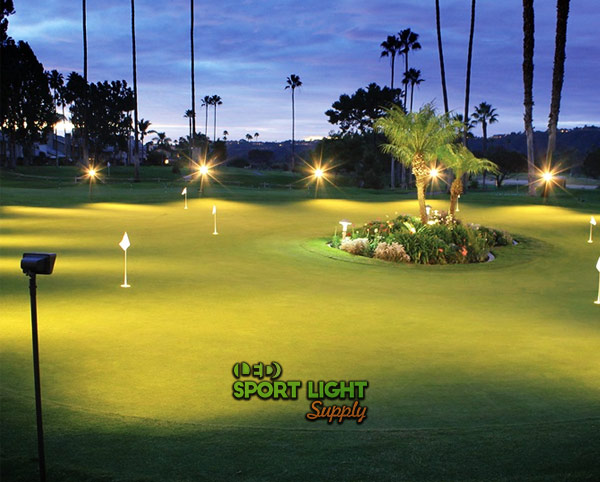
For Night-Time Golf Practice
Putting green lights are essential for those who prefer to practice their golf skills during the night. Adequate illumination allows golfers to clearly see the holes and their golf balls, making night-time practice both feasible and enjoyable. A well-designed lighting system not only enhances visibility but also ensures that the brightness levels are comfortable for the eyes, preventing strain. Furthermore, an effective lighting setup can attract more golfers to the course, encouraging repeat visits and potentially increasing revenue.
Optimize the Night-Time Usage of Putting Green Court
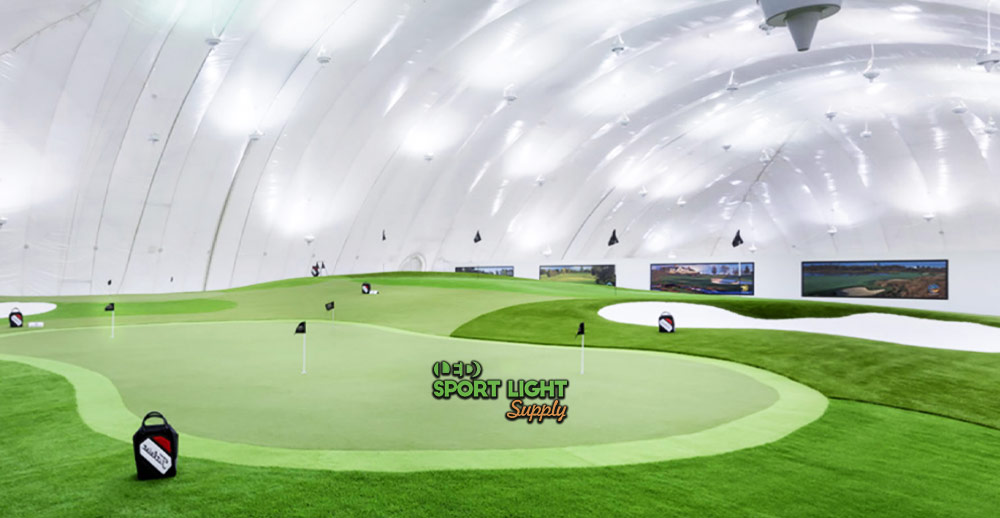
To maximize the revenue from your putting green, consider extending operating hours into the night. This approach can draw in additional customers, especially if you adopt an energy-efficient and reliable lighting solution like LED lights. LED putting green lights are an excellent choice due to their durability and low energy consumption. By extending the hours of operation, you offer more time slots for members, reducing crowding and enhancing the overall experience at your golf course.
Attract Golfers
A well-lit putting green contributes significantly to the professional appearance of a golf club. When given a choice, golfers are likely to prefer a brightly illuminated putting green over one that is poorly lit and difficult to see. High-quality lighting not only improves visibility but also enhances the appeal of your golf course. Satisfied customers are more likely to renew their memberships, making professional lighting a worthwhile investment.
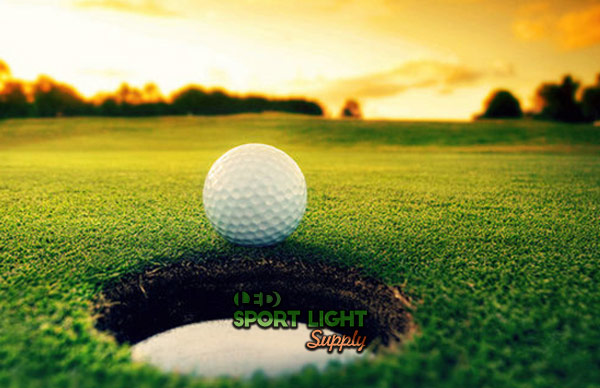
Create a Relaxing Atmosphere
For many, golf is a way to unwind and de-stress. The right lighting can help create a calming atmosphere that complements this experience. Opting for warm white LED lights with a color temperature of 2700K to 3500K can foster a cozy, inviting environment. Such lighting can make the putting green a more pleasant place to play, enhancing the overall enjoyment for golfers and adding to the appeal of your club.
Safety and Security
Putting greens often feature uneven terrain, which can lead to accidents if not properly illuminated. A robust lighting system helps reduce the risk of accidents by making obstacles and hazards more visible to golfers. Additionally, motion-sensing lighting can enhance security by deterring unauthorized access. By integrating these lights with an alert system, golf club staff can quickly respond to any security breaches, ensuring the safety of both the property and its patrons.
Outdoor & Backyard Putting Green Lighting Ideas
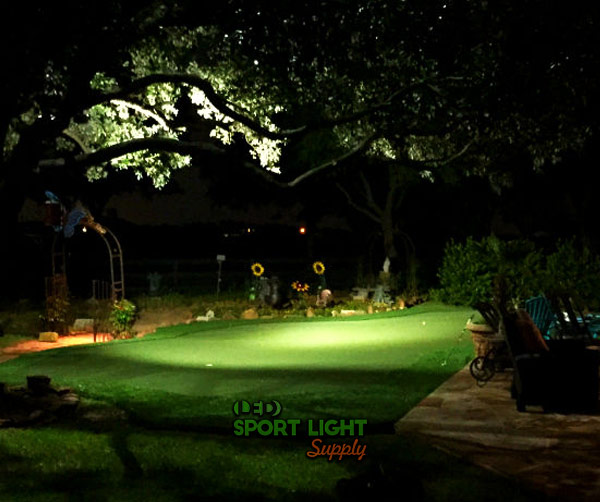
Flood Lights for Outdoor Putting Green Areas
Flood lights are an excellent choice for illuminating large outdoor putting green areas. With their wide beam angles, typically ranging from 60° to 90°, they effectively cover expansive spaces. However, due to their broad beam dispersion, flood lights are better suited for close-range illumination rather than detailed, focused lighting. They provide ample light for general visibility across the putting green, making them ideal for larger areas where uniform light distribution is necessary.
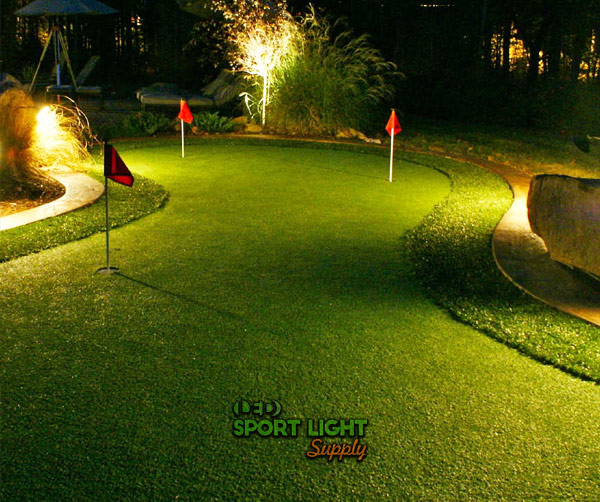
Spot Lights for Small Golf Practice Fields
For smaller golf practice fields, spot lights are a more suitable option. These lights feature a narrower beam angle, usually between 10° and 30°, which allows for concentrated illumination over long distances. Spot lights are perfect for targeting specific areas of the putting green, such as a particular hole or practice spot, with fewer light poles. Their focused beam helps highlight key areas without spreading light excessively.
Down Lighting for Creating a Relaxing Atmosphere
Down lighting is primarily used to create a soothing and relaxing ambiance on the putting green. Typically installed at a height of 1 to 2 meters, down lights are not designed to cover large areas. Instead, they are used to illuminate specific features such as golf holes or surrounding trees. The gentle, downward light helps create a calm and inviting environment, enhancing the overall experience for golfers looking to unwind.
Solar Lighting for Hassle-Free Installation
For a simple and low-maintenance lighting solution, solar putting green lights are highly effective. Unlike traditional lighting systems that require digging and wiring, solar lights are easy to install by simply inserting the “wireless” poles into the ground. These lights are powered by solar panels that charge the batteries during the day, allowing them to operate autonomously. While the initial cost may be higher, solar lights offer significant savings on electricity and maintenance in the long term.
Dusk to Dawn Lights for Automatic Operation
Dusk to dawn lights offer the convenience of automatic operation, eliminating the need for manual switching. These lights are equipped with photocells that detect changes in light intensity. They automatically turn on at dusk and off at dawn, ensuring the putting green is always illuminated during the evening without requiring constant attention. This feature is especially useful for outdoor putting greens, providing hassle-free and energy-efficient lighting.
Color-Changing Flood Lights
Color-changing flood lights can add a dynamic visual element to your putting green. Utilizing DMX 512 protocol, these RGB flood lights can produce up to 16 million colors and even display multiple colors simultaneously. This capability allows for impressive light shows that can make your golf club a standout destination. With the ability to create vibrant and engaging lighting displays, color-changing lights are sure to attract attention and enhance the overall experience for visitors.
Putting Green Hole Lights vs. Flood Lights
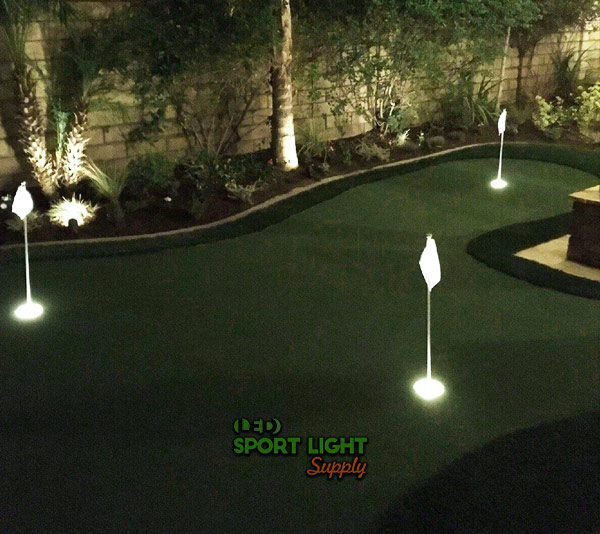
What is Putting Green Hole Lights?
Putting green hole lights are designed specifically to illuminate the area surrounding the golf hole. Their primary purpose is to help golfers easily locate the target on the putting green. This type of lighting is more energy-efficient compared to general flood lighting because it focuses only on the immediate area around the hole, rather than lighting up the entire putting green.
What is Putting Green Flood Lights?
In contrast, flood lights are used to provide comprehensive illumination for the entire putting green. These lights are typically mounted on high mast poles, ranging from 10 to 20 meters in height. Flood lights are high-powered, often exceeding 500 watts, to ensure that the entire putting green is well-lit. They are ideal for large areas where uniform lighting is required.
Hole Lights or Flood Lights, Which is Better?
To determine which type of lighting is better for your needs, consider the following comparisons:
| Feature | Hole Lights | Flood Lights |
|---|---|---|
| Installation | Simple installation; no wiring needed under the turf | Requires installation on high mast poles; more complex |
| Cost | Budget-friendly for homeowners or golfers | Higher cost due to equipment and installation |
| Lighting Uniformity | Lower; may cause dim spots that strain the eyes | Brighter and more uniform illumination |
| Light Pollution | Less light pollution as lights are pointed downward | Higher light pollution due to broader light spread |
Both types of lighting have their advantages depending on the specific needs of your putting green. Hole lights offer a cost-effective and focused lighting solution, while flood lights provide extensive, uniform illumination at a higher cost.
Putting Green Lighting Design and Standards
Lux (Brightness) Requirement
For putting green lighting, the horizontal lux requirement typically ranges between 50 and 100 lux. “Lux” is a unit used to measure brightness on a surface. You can easily measure lux levels using a smartphone by downloading a “lux meter” application, which utilizes the front or rear camera as a meter.
In addition to horizontal brightness, the vertical lux level should be around 100 to 300 lux to ensure adequate illumination on vertical planes. Meeting both horizontal and vertical lux requirements allows golfers to clearly see the trajectory of the golf ball and the holes.
Lighting Uniformity
Lighting uniformity is a critical aspect of putting green design, referring to the ratio between the average lux and the maximum or minimum lux levels. For example, if the average lux at various points is 40 lux, while the maximum is 100 lux, the lighting uniformity is 0.4.
For recreational putting greens, a lighting uniformity of 0.4 to 0.6 is recommended. This range helps to prevent eye strain and ensures a more comfortable experience for golfers.
Color Temperature
Choosing the right color temperature is essential for creating the desired atmosphere. For a warm and inviting putting green, opt for LED lights with a color temperature of 2700 to 3500K, which emit a yellowish-orange light. This warmer tone contributes to a more relaxed environment.
In contrast, for competitive golf courses where accuracy and clarity are crucial, cooler white lights with a color temperature above 5000K, simulating natural daylight, are preferable.
CRI (Color Rendering Index)
The Color Rendering Index (CRI) for putting green lighting should be around 70 to 80. A higher CRI ensures that golfers can see the true and vivid colors of the turf and flag poles, enhancing the overall visual quality of the green.
Flicker-Free Lighting
Flickering lights can negatively impact the golfers’ experience by causing visual discomfort and making it difficult to see the golf flags and obstacles. To avoid such issues, choose putting green lights with a flicker rate lower than 0.03%. This minimizes the fluctuation in lumen output, ensuring stable and consistent lighting.
Glare-Free Lighting
Glare can be a significant issue with artificial lighting, causing discomfort when looking directly at intense lights. To achieve glare-free lighting, consider the following methods:
| Approach | Description |
|---|---|
| Large Beam Angle | Use flood lights with a large beam angle to reduce light concentration and minimize glare. |
| Strategic Installation | Plan the installation of putting green lights to avoid direct line of sight to the floodlights, thereby reducing glare. |
Putting Green Lighting Layout
Putting Green Light Pole Height
The height of the light poles for putting greens typically ranges from 8 to 20 meters. Taller high mast poles are generally preferred as they enhance lighting uniformity and help to reduce glare. By elevating the light poles, you ensure that the flood lights can cover a larger area of the putting green more evenly, distributing light more effectively.
However, it’s important to consider that higher light poles come with increased costs for both the poles themselves and their installation. Despite these additional expenses, the benefits of improved lighting quality and reduced glare often justify the investment.
Number of Poles
The number of light poles required depends on the size and shape of your putting green. Typically, you would need between 4 and 8 poles. Each pole can effectively illuminate an area with a diameter of approximately 50 to 100 meters. Given the varying dimensions and shapes of putting greens, it’s essential to customize the lighting design accordingly. For putting greens with more complex shapes, additional poles may be necessary to ensure even and adequate illumination.
Position of the Light Poles
Optimal placement of light poles is crucial for achieving effective lighting on the putting green. Ideally, poles should be positioned at the corners of the putting green. This placement helps to minimize glare and maximize lighting uniformity. For the best lighting results, light poles should be evenly distributed across the green. Consistent spacing between adjacent poles facilitates more uniform illumination and helps avoid areas of excessive brightness or darkness.
Why Use LED Putting Green Lights to Replace Metal Halide, HPS, or Mercury Vapor Lights?
More Energy Efficiency
LED lights offer superior energy efficiency compared to metal halide (MH), high-pressure sodium (HPS), and mercury vapor lights. LED technology boasts a luminous efficacy of up to 150 lumens per watt, significantly higher than the 75 lm/W of metal halide and the 50 lm/W of mercury vapor lights. By replacing traditional high-intensity discharge (HID) lights with LED lights, you can achieve substantial savings on electricity and maintenance costs over time, despite the higher initial investment in LED technology.
Solar Panel Compatibility
The trend towards solar lighting for putting greens is growing, and LED lights are compatible with solar panels. By opting for LED solar lights, you eliminate electricity costs altogether, as the system operates independently using solar energy. This combination of LED and solar technology not only reduces energy expenses but also contributes to a more sustainable and eco-friendly lighting solution.
Longer Life Span
LED lights have a much longer lifespan compared to traditional lighting options. LEDs can last up to 150,000 hours, whereas halogen flood lights typically last around 3,000 hours and metal halide lights about 10,000 hours. The extended lifespan of LEDs translates into lower maintenance costs and fewer replacements, making them a cost-effective long-term investment.
Smart Lighting Control
LED lights offer advanced smart lighting control options. With support for WiFi connectivity, LED lights can be controlled via smartphone apps or computer software. This capability allows for easy adjustment of brightness and the ability to switch lights on or off remotely, providing greater convenience and flexibility in managing the lighting on your putting green.
Conclusion
Upgrading to LED lights for your putting green can significantly enhance the lighting quality and golfer’s experience. By considering the benefits of energy efficiency, solar compatibility, extended lifespan, and smart control features, you can make an informed decision that improves both performance and cost-effectiveness in your lighting system.
